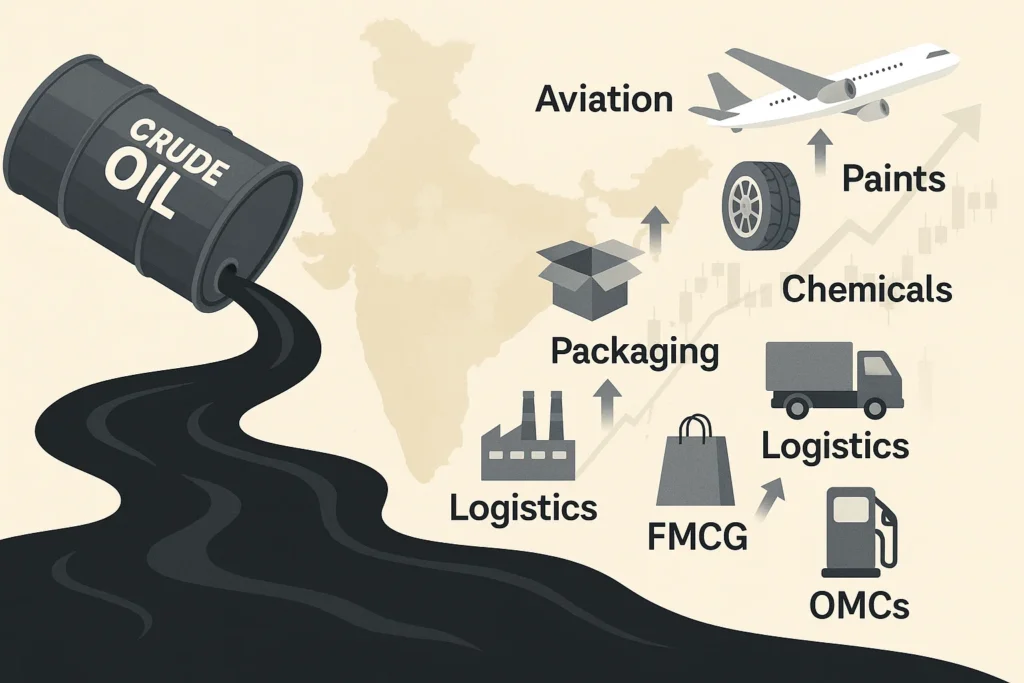There’s a quiet celebration happening in Dalal Street—no drums, no fireworks, but if you listen closely, you’ll hear the sigh of relief from investors, airlines, paint companies, and even the Reserve Bank of India. The reason? Falling crude oil prices.

Now, we’re not just talking about a minor dip. Crude oil has been in freefall this year—down a staggering 30% since January 2025. And just recently, it took another 4% hit. The trigger? OPEC+—the cartel of oil-producing nations—decided to increase output by over 400,000 barrels per day in June, essentially flooding an already nervous market. Combine that with global demand concerns, and you get oil prices diving faster than an IPL batter chasing a wide delivery.
But what does this mean for India—a country that imports nearly 85% of its oil? In simple terms: this is jackpot season for the Indian stock market.
India’s Oil Dependency: From Weakness to Strength
In most situations, being dependent on imports is seen as a weakness. But when prices crash? That very dependency flips into strength. Every dollar drop in crude means billions saved on India’s import bill. And that doesn’t just please policymakers—it lights up entire sectors across the Indian economy.
Because crude oil isn’t just about fuel. It’s the invisible thread running through aviation, paints, tyres, packaging, logistics, chemicals, and much more.

Airlines Glide, Paints Shine, Tyres Grip—Why These Sectors Are Smiling
Let’s begin with the most obvious winner—aviation. For airlines like IndiGo, fuel costs make up nearly 40% of operational expenses. A sharp fall in ATF (Aviation Turbine Fuel), which is directly tied to crude oil, immediately widens their profit runway. It’s simple math: lower fuel costs = better margins = potential fare wars = more bookings = even better margins.
Next up, the paint industry. It’s not just about colours—it’s chemistry. Paint manufacturers rely on crude-based inputs like solvents and resins. A fall in crude prices directly eases their raw material burden. Asian Paints, Berger Paints, and others could find themselves turning in stronger operating margins this quarter—and that too without increasing prices.
Then there’s the tyre sector. Synthetic rubber, used extensively in tyre production, is derived from—you guessed it—crude oil. With costs falling, companies like MRF and CEAT suddenly find more grip in their financials, especially at a time when vehicle sales are steady and roads are busier than ever.
And let’s not forget FMCG companies. While they don’t deal with oil directly, their packaging vendors do. Plastics used in packaging—from shampoo sachets to biscuit wrappers—come from crude derivatives. So when crude falls, the ripple reaches FMCG boardrooms. Brands like HUL, Nestlé, and Dabur can now absorb rising food input costs without hurting margins. That’s what falling crude quietly does—it balances your books.
Even the Oil Companies Win (Yes, Seriously)
Now here’s the twist. You’d think oil marketing companies like IOC, BPCL, and HPCL would suffer from falling crude. After all, their product—petrol and diesel—becomes cheaper, right?
Wrong.
In reality, lower crude prices reduce their procurement costs. If fuel prices at the pump don’t change immediately, these companies enjoy better gross refining margins (GRMs). The gap between what they pay for crude and what they earn on products like petrol, diesel, and aviation fuel becomes wider. Think of it as making cheaper laddoos and still selling them at the same MRP—sweet deal, right?
Logistics and Chemicals: The Quiet Gainers
Imagine running a logistics company like Blue Dart or Delhivery. Fuel is your oxygen. Every drop in diesel price—driven by cheaper crude—adds directly to your bottom line. Fewer fuel surcharges, lower delivery costs, and healthier margins. As e-commerce booms, these savings start compounding fast.
Then there’s the chemicals sector, which often gets overlooked in such discussions. From agrochemicals to polymers, the entire chain begins with hydrocarbons—most of them derived from crude. As oil gets cheaper, raw materials become less expensive, making room for margin expansion or price competitiveness. Companies like Aarti Industries or Deepak Nitrite could quietly outperform.
Let’s Visualize This: Who Gains, and How
| Sector | Winners | Why They Benefit |
|---|---|---|
| Aviation | IndiGo | ATF cost down = margin up |
| Paints | Asian Paints, Berger | Crude inputs fall = lower raw material cost |
| Tyres | MRF, CEAT, Apollo | Synthetic rubber cost down |
| FMCG | HUL, Nestlé, Dabur | Packaging cost down = margins protected |
| OMCs | IOCL, BPCL, HPCL | Better refining margins if retail prices stay stable |
| Chemicals | Aarti Industries, SRF | Cheaper input chemicals |
| Logistics | Blue Dart, Delhivery | Diesel down = direct margin lift |
Beyond Stocks: The Macroeconomic Tailwind
Zooming out from Dalal Street for a moment, the benefits to the larger Indian economy are just as exciting.
Lower crude means a smaller import bill, which directly helps reduce the Current Account Deficit (CAD). A narrow CAD helps keep the rupee stable—great news for foreign investors who often worry about currency risk.
More importantly, falling crude oil prices also cool inflation. Transport costs go down. Production becomes cheaper. And the domino effect can even bring down food prices. If this continues, the RBI gets breathing room. With inflation under control, it may avoid hiking interest rates—or even cut them if needed.
And we all know what happens when interest rates go down: borrowing becomes cheaper, businesses invest more, and the stock market throws a party.
What Should You, the Investor, Do?
If you’re wondering whether this is the time to act—the answer is yes, but smartly. Don’t chase every stock that’s remotely connected to oil. Focus on those with high crude exposure and strong fundamentals. Monitor upcoming results—watch how margins change and how managements guide future expectations.
Remember, falling crude is a tailwind. But to ride it well, you still need the right vehicle.
A Final Word
The market doesn’t always give you free gifts. But when falling crude oil prices align with India’s import-heavy profile, it’s as close as you get to one. For both retail investors and institutional players, this is a macro event that unlocks micro opportunities.
Want to make the most of it?
👉 Open a free Demat account with Angel One and access research-backed ideas, real-time screeners, and the tools you need to ride this trend—before the crowd catches on.
FAQs
1. What does falling crude oil prices mean for India?
It means lower import costs, reduced inflation, and positive macroeconomic impact since India imports most of its oil.
2. Which sectors benefit from falling crude oil prices?
Aviation, paints, tyres, chemicals, logistics, FMCG, packaging, and oil marketing companies (OMCs) benefit the most.
3. How do aviation stocks gain from cheaper crude?
Lower crude means cheaper ATF (aviation fuel), reducing operational costs and boosting airline profit margins.
4. Why do paint companies benefit?
Paints use crude oil derivatives as raw materials. Cheaper crude reduces input costs and improves margins.
5. How does the fall in oil prices affect tyre companies?
Tyre makers use synthetic rubber, which is crude-based. Falling oil prices make raw materials cheaper.
6. What is the impact on FMCG and packaging companies?
Plastic packaging becomes cheaper, reducing overall production costs for FMCG players.
7. Do oil marketing companies lose money when oil prices fall?
Not necessarily. Lower input costs can improve refining margins if retail fuel prices remain steady.
8. Does falling crude help the Indian economy overall?
Yes, it narrows the current account deficit and eases inflation, strengthening the economy.
9. How does this affect RBI and interest rates?
Lower inflation gives the RBI room to pause or reduce interest rates, which supports economic growth.
10. Should investors buy stocks when crude oil falls?
If crude stays low, sectors like aviation, logistics, and paints may outperform—making selective investing a smart move.
Related Articles
Investing in Cybersecurity: The Growing Importance and Investment Potential in India






